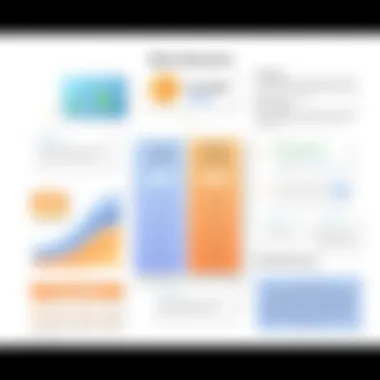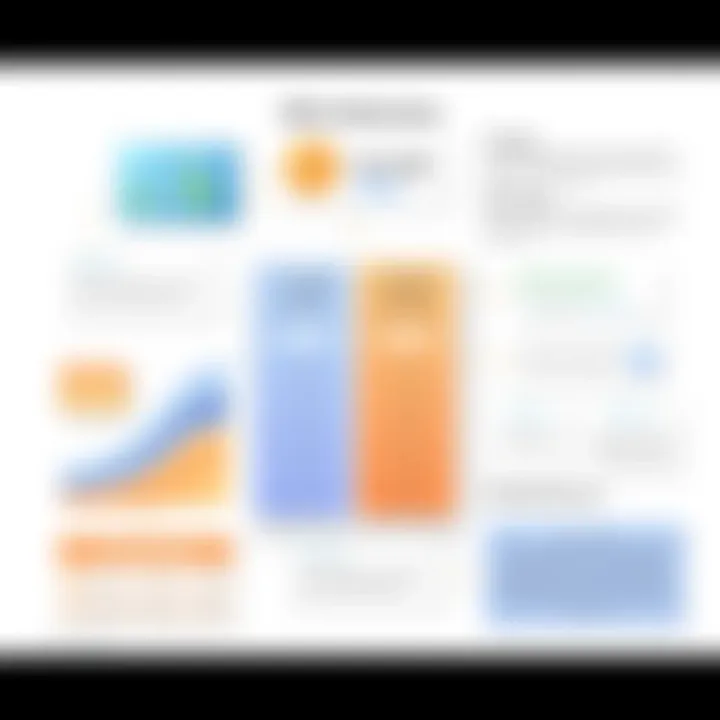Understanding Wave Accounting Pricing Structures


Intro
When considering financial management solutions, one often encounters various platforms vying for attention. Wave Accounting stands out, thanks to its promise of accessible and intuitive software tailored for small to medium-sized businesses. However, the question at hand is: what does it cost? Each feature, tier, and additional service can alter the financial implications significantly.
Understanding the pricing structures not only brings clarity to what’s available but also assists businesses in making well-informed decisions. This scrutiny goes beyond mere numbers to examine the overall value proposition and how it aligns with specific business needs. From dissecting core functionalities to weighing pros and cons, let’s unravel the layers of the financial commitment involved in adopting Wave Accounting.
Key Features of the Software
Overview of Core Functionalities
Wave Accounting offers a range of features designed to streamline financial management. At its core, the software includes invoicing, expense tracking, and report generation. Users can expect a user-friendly interface that caters to those who may not have a financial background. Key features include:
- Invoicing: Create professional invoices easily, allowing for customization in terms of branding and payment options.
- Expense Tracking: Users can effortlessly record expenses and categorize them, giving a clear snapshot of financial health.
- Financial Reporting: Generate essential financial statements like profit and loss reports, designed to provide insights without requiring in-depth knowledge of accounting principles.
These functionalities form the backbone of Wave Accounting, allowing business owners to focus on their operations rather than getting lost in numbers.
Unique Selling Points
What sets Wave Accounting apart from its competitors? One distinguishable factor is that a significant portion of its services is available free of charge. This can present a tantalizing option for startups and small businesses that must closely manage cash flow.
- No Monthly Fees: Unlike many competitors, the primary features of Wave Accounting do not carry monthly fees, making it accessible without upfront investment.
- Enhanced Customer Support: Dedicated customer service provides guidance, which is vital when navigating a financial platform.
- Third-Party Integrations: Seamless integration with platforms like PayPal and Etsy allows for smooth data management across different channels.
In-Depth Software Analysis
Pros and Cons
While Wave Accounting shines in many respects, it’s not without limitations. Evaluating both the advantages and the drawbacks presents a fuller picture:
Pros:
- User-friendly and visually appealing interface.
- Comprehensive features at no upfront costs.
- Strong support and community resources.
Cons:
- Limited scalability for larger businesses.
- Certain premium features remain outside free tier, potentially complicating budgeting.
- Some users report occasional bugs, particularly during software updates.
Performance Metrics
Performance metrics reflect the software's capability in real-world scenarios. Reviewers often highlight the speed of generating reports and the reliability of invoice delivery. Calculating efficiency not only considers these elements but also evaluates how Wave Accounting performs under pressure during peak usage times. For business owners, this can mean the difference between smooth operations and financial chaos.
"A tool that doesn't support your business as it grows can quickly become an anchor instead of a help."
Understanding this helps in assessing whether now is the right time to invest in Wave Accounting or if waiting for potential updates would be more prudent.
By diving deep into the pricing structure and features of Wave Accounting, businesses can make decisions that align their financial management with broader goals. This comprehensive exploration is essential, not just for immediate needs but for future growth as well.
For additional insights on financial management software, you might want to check out resources on Wikipedia or Britannica.
By grasping the ins and outs of Wave Accounting, business owners are better positioned to leverage the software's capabilities in harmony with their financial strategies.
Prelims to Wave Accounting
In the landscape of financial management solutions, Wave Accounting stands out as a noteworthy option for small and medium-sized businesses, entrepreneurs, and freelancers. This accounting software is cloud-based and offers a unique value proposition: many features are accessible without a price tag attached. As businesses look to streamline their financial operations, understanding Wave Accounting’s offerings becomes crucial in making an informed choice. This introduction serves as a gateway into the essential elements that will be explored in detail, particularly focusing on its pricing structure.
Overview of Wave Accounting
Wave Accounting offers solutions designed to simplify the tasks of bookkeeping, invoicing, and accounting without the hefty price often associated with such services. Founded in 2010, the company has crafted a platform that caters primarily to the needs of smaller enterprises. Users find various features like expense tracking, revenue management, and automated invoicing—all combined into an intuitive interface. This focus on ease of use combined with robust functionality sets the stage for businesses looking for simplicity without sacrificing capability.
Wave Accounting operates on a freemium model, meaning basic features are available at no cost while more advanced capabilities come with fees. This model attracts many business owners who may hesitate about upfront investments in accounting software. By offering a glimpse into what's available for free, it allows potential users to gauge their interest and the software's suitability for their needs without financial commitment. For many startups, this can mean the difference between struggling with financial management and having a tool to aid in their growth.
Importance of Pricing in Software Selection
When it comes to selecting software for business operations, pricing plays a pivotal role. It’s not just about the cost itself; it's also about understanding what you get for that price. Wave Accounting's pricing structure must be considered carefully as it encompasses not just the monthly or annual fees but also potential hidden costs, support fees, and the value of the features provided.
A savvy business owner thoroughly evaluates how pricing aligns with the company’s financial strategy and future growth plans. Feature richness relative to cost can be a decisive factor. For instance, while a feature may appear to be beneficial, if it comes with a steep price hike, businesses need to weigh this against their actual needs and usage potential.


Moreover, the growing trend towards cloud-based solutions adds another layer to the evaluation process. With subscriptions and tiered pricing becoming the norm, understanding what helps differentiate offerings becomes crucial. Is Wave Accounting competitive compared to others like QuickBooks or FreshBooks? Do the free features cover the basics without leaving users wanting more? In essence, the pricing and its implications must be woven closely into the overall desire for efficiency and cost-effectiveness in business operations.
"The wrong choice can cost a company more than just money—it can cost time, resources, and even a smoother operational flow."
By understanding the nuances of Wave Accounting's pricing, business owners can make choices that align with their financial goals, ensuring they’re not just purchasing software but strategically enhancing their business processes.
Understanding Wave Accounting Pricing
When it comes to software, especially one that handles crucial financial data like Wave Accounting, understanding the pricing landscape is key. Pricing isn’t just about costs; it’s about value. Knowing how Wave structures its pricing can help users—especially small to medium-sized businesses, freelancers, and entrepreneurs—make informed decisions. This examination will shed light on the typical pricing model of Wave Accounting, the features available at no charge, and the additional services that come with fees.
Base Pricing Model
Wave Accounting adopts a straightforward pricing approach that many small business owners might find appealing. At its core, Wave promotes a unique blend of free access and paid features, allowing users to dive into the software without any initial financial commitment. It’s generally hailed as a free accounting software tailored for small businesses; however, there are nuances to this so-called ‘free model.’
For example, the base model provides users the ability to manage income and expenses, invoice clients, and even generate reports—all without spending a dime. Unlike many competitors, Wave does not impose monthly fees for its fundamental services. However, keep in mind that while the initial cost might be zero, depending on your business needs, additional paid services could emerge later on. This aspect is crucial for businesses as it lays the foundation for evaluating whether the software is truly the right fit.
Free Features and Limitations
While the free features of Wave Accounting are impressive, they do come with certain limitations that users should be aware of. Here are some highlights and critiques based on user experiences:
- Invoicing & Basic Reporting: Users can create invoices, track payment statuses and generate basic financial reports without charge.
- User Limits: Unlike other accounting platforms, Wave allows unlimited clients or customers for free, a feature that is amazingly beneficial for businesses that are just starting out.
- Integrations: The software can connect with third-party payment processors like PayPal, but again, these features can vary in the level of functionality offered for free.
Nonetheless, there are catch-22s. For instance, while basic services are free, other features such as payroll services come with a price tag. Additionally, advanced reporting capabilities are often locked behind a paywall, meaning users seeking more in-depth insights will need to consider the costs of unlocking these functionalities.
"Understanding what is included—or excluded—in the free offer can save businesses unexpected costs down the road."
Paid Services and Their Costs
Once businesses assess their requirements, the next logical step is understanding the paid services Wave offers. Here, we’ll delve into what those services are and associated costs:
- Payroll Services: One popular service that incurs fees is payroll, which is offered at $35 per month plus an additional $6 per employee. This can be particularly useful for small business owners who need a reliable payroll solution but should be weighed against competitors.
- Payment Processing Fees: While invoicing might be free, receiving payments through credit cards or bank transfers comes with transaction fees. For example, credit card payments have a fee of 2.9% plus 30 cents per transaction. This is essential to remember for budgeting cash flow effectively.
- Upgrades for Reports: Advanced reporting features allow for deeper insight into the business’s financial health. Pricing for such upgrades varies, but typically, users could expect charges that reflect the complexity and value these features provide.
By examining these costs, business owners can align their selections with their financial commitments. Balancing initial free offerings with the potential expenses can ultimately influence the overall decision-making process with respect to Wave Accounting.
Breakdown of Key Features
Understanding the key features of Wave Accounting is essential for various reasons, especially when evaluating its viability as a financial management option for small to medium-sized businesses. The right accounting tools can streamline your operations, enhance accuracy, and ultimately save time and money. By breaking down the integral features, readers will gain insights into how Wave Accounting stands out and what unique benefits it offers.
Accounting and Bookkeeping Tools
At the heart of Wave Accounting is its robust accounting and bookkeeping functionality. This isn't just about basic number-crunching; it’s about providing a comprehensive suite of tools that can handle everything from expense tracking to bank reconciliations. One significant advantage is that Wave Accounting allows users to connect their bank accounts directly, which enhances accuracy and reduces manual data entry. This means business owners can spend less time on tedious tasks and more on growing their businesses.
- User-friendly Interface: The intuitive layout makes it easy for those who aren’t seasoned accountants to navigate through various financial records without feeling overwhelmed. Users can quickly access invoices, expenses, and reports, giving them a clear overview of their financial health.
- Multi-currency Support: For businesses dealing with international clients, the ability to manage multiple currencies is a game-changer. This feature ensures that exchange rates are applied correctly, simplifying financial management for businesses that operate on a global scale.
- Integration with Other Tools: Wave Accounting plays nicely with various third-party apps, such as PayPal or Shopify, allowing round-the-clock synchronization for seamless bookkeeping. This interconnectedness creates a cohesive ecosystem for handling finances.
Invoicing and Payment Processing
Invoicing can often become a sore spot for many small businesses, but Wave Accounting has crafted a solution that simplifies this process significantly. The platform allows users to create customized invoices that reflect their brand identity while providing flexibility in payment options.
- Quick and Simple Invoicing: Users can generate invoices in a matter of minutes with customizable templates that allow for branding modifications. This means you can add your logo and choose the layout that resonates with your business image.
- Online Payment Integration: One of the standout features is the ability to accept online payments. Clients can pay directly through their invoices, making it convenient for both parties. This can lead to faster payment cycles, improving cash flow for small businesses.
- Recurring Invoices: For businesses with subscription models or ongoing services, Wave enables users to set up recurring invoices. Once established, you can save valuable time on repetitive billing tasks, and clients appreciate the consistency of billing without surprises.
Financial Reports and Analytics
The importance of financial reporting cannot be overstated; regular insights into performance metrics can make or break a business. Wave Accounting offers its users a range of financial management reports that can help pinpoint areas needing attention while highlighting strengths.
- Comprehensive Reporting: The platform provides various reports, including profit and loss statements, balance sheets, and cash flow reports. This wealth of data helps inform decisions that affect the future of the business.
- Customizable Dashboards: Users can create their dashboards to monitor key performance indicators specific to their operations. This level of customization means you see what matters most to you at a glance.
- Data-driven Decision Making: With access to analytical tools and reports, business owners can make informed choices regarding their finances, investments, and strategic planning. Utilizing these features can lead to more substantial growth and stability over time.
"The tools you choose can either be an anchor or a catalyst for your business growth."
By delving into these key features, Wave Accounting proves to be more than just another financial management tool. It's an ally equipped to help businesses navigate the often choppy waters of finance. As we move forward, comparing these attributes with competitors offers a more informed perspective on the overall value Wave Accounting truly provides.
Pricing Comparison with Competitors
When it comes down to choosing the right accounting software, pricing comparison among competitors is key. It's not just about the cost but also about understanding what you truly get for your buck. Customers today are more informed than ever; they seek value, clarity, and—most importantly—a platform that aligns with their specific business needs. Comparing Wave Accounting with its competitors sheds light on how it stands in terms of features, usability, and overall cost-efficiency.
Wave Accounting vs. QuickBooks


In the battle of the titans, Wave Accounting and QuickBooks often clash. QuickBooks is a well-established player in the accounting software arena. It offers a wide array of features such as extensive reporting, inventory management, and payroll functions. However, its costs can spiral quickly. For example, QuickBooks Online has various tiers, starting with a basic plan that covers invoicing and expense tracking but leaves out many features unless you opt for more expensive plans.
Wave, on the other hand, provides its core services for free, targeting small businesses and solopreneurs. Yet, that free service comes with limitations, primarily in integrations and overall scalability. If you're a small outfit, Wave might save you some precious dollars. But if you're eyeing rapid growth, you might find its limitations problematic down the line. So, weighing your projected growth against immediate costs is vital.
Wave Accounting vs. FreshBooks
FreshBooks and Wave are both designed with small businesses in mind, but they approach pricing differently. FreshBooks offers a more user-friendly interface and robust customer support, albeit at a price. The entry-level plan includes invoicing, expense tracking, and time tracking, which caters well to freelancers. However, even the basic FreshBooks plan incurs a monthly fee, which can add up, especially for those just starting.
In contrast, Wave's most enticing feature is its free invoicing and accounting. This might make it a better pick for startups and small businesses who want comprehensive solutions without the fiscal pressure. However, for those who value easy navigation and responsive customer service, FreshBooks could justify its cost in a way that Wave doesn't.
Wave Accounting vs. Xero
Xero rounds up the trio of major competitors. Much like QuickBooks, Xero's pricing reflects a tiered structure, allowing users to scale as their needs evolve. Its robust features include excellent inventory management and multi-currency support, which are appealing to growing businesses. However, these features come at a recurring cost that might be hard to ignore.
Wave’s simplicity and foundational offerings can make it an attractive option for businesses just beginning to use software for accounting. If you're looking at only the basic functionalities, Wave might win for pricing. But if you're aiming toward a larger scale of operations and foresee needing those additional capabilities, Xero might better serve your anticipated needs despite the higher costs.
"In the world of accounting software, the lowest price doesn’t always mean the best deal; anticipate your requirements to avoid the pitfalls of overspending on features you won't benefit from."
In closing, the choice between these platforms boils down to specific business needs and future growth potential. If you want to keep initial investment low while managing your books effectively, Wave could indeed be the winning ticket. But for businesses anticipating rapid scaling, QuickBooks, FreshBooks, or Xero may ultimately offer a more supportive structure as you grow.
Evaluating Total Cost of Ownership
In the landscape of accounting software, pricing often transcends simple subscription fees. It’s vital for business owners and decision-makers to grasp the broader financial implications, leading us to the concept of Total Cost of Ownership (TCO). This idea incorporates not only the visible expenses but also hidden costs that may sneak up on you, like a cat in the night. To make an informed decision regarding Wave Accounting, let’s delve into initial costs and the long-term investment needed, alongside the potential hidden fees that could impact your overall experience.
Initial Costs and Long-Term Investment
When a business considers adopting Wave Accounting, they must first look at the initial costs. Most enticingly, the service is free for basic offerings, which already gives it a leg up over competitors. However, as the old saying goes, "There's no such thing as a free lunch." While you may not pay upfront fees, businesses should anticipate costs that could arise as they expand and require more advanced features.
- Setup Costs: Even though there’s no direct charge, companies must factor in the time and resources needed for setup. If your team isn’t familiar with the interface and the processes of Wave, this could mean additional hours spent learning and integrating.
- Upgrades and Add-ons: As business needs grow, users may feel the urge to explore add-ons like payroll or payment processing. Each of these features has its own set price, which accumulates over time.
- Training: Depending on team size and software mastery, training sessions may become necessary. This expense, while not immediate, is worth future-proofing your investment.
Engaging in a thoughtful dialogue about long-term investment is crucial. While initial costs might seem attractive, the idea is to look beyond the surface. How much will your accounting processes cost in terms of time and additional features as you scale? A focus on long-term efficiency can often yield greater dividends than simply choosing the lowest price point at the beginning.
Potential Hidden Fees
In the intricate nature of software pricing, hidden fees can often become the proverbial elephant in the room. While Wave Accounting promotes itself as a cost-effective solution, there are subtleties that require careful consideration. Specific areas to watch out for include:
- Transaction Fees: For those using transaction processing features, there could be various charges per transaction that add up faster than a speeding ticket.
- Payment Processing Fees: If you’re not careful, the fees connected to credit card transactions can erode the value you think you are getting from otherwise free adds-ons, amplifying costs.
- Service Reliability: If service downtimes lead to operational hiccups, you might face indirect costs such as lost sales or customer dissatisfaction.
- Support Costs: Sometimes getting quick answers from customer service may require a higher tier or premium support service, which can contribute to overall spend.
In this mobile landscape where adaptability is key, understanding the hidden expenses associated with Wave Accounting will support strategic decision-making.
In a nutshell, evaluating TCO isn't merely dissecting service fees; it's envisioning the financial journey, aligning costs with expected benefits, and avoiding surprises lurking around the corner.
By proactively assessing these components—initial costs, long-term investments, and hidden fees—businesses can effectively navigate the intricate web of Wave Accounting's pricing and unleash its full potential.
Value Proposition of Wave Accounting
Understanding the value proposition of Wave Accounting is paramount for business owners and decision-makers. The essence of this proposition lies not just in the pricing, but rather in evaluating what users truly gain from the platform. Given the competitive landscape of accounting software, the following elements are crucial in illustrating Wave Accounting's unique value: its cost-effectiveness, flexibility, and user-centered interface.
Assessment of Usability
A standout feature of Wave Accounting is its user-friendliness. Many accounting solutions have a steep learning curve, but Wave allows users to dive straight into management tasks without needing a degree in finance. Its layout is designed with clarity in mind, guiding users through their financial data with minimal clutter.
- Intuitive Navigation: Users can easily move between different modules like invoicing, payroll, and reports without feeling lost. As they say, "It's as easy as pie!"
- Visual Cues and Portability: With well-placed tooltips and a mobile-friendly interface, managing finances on-the-go becomes a non-issue. Whether on a laptop at a cafe or on a phone in a cab, your accounting tools are at your fingertips.
- Customization Options: Business owners have the ability to tweak settings, enabling them to mold their accounting environment to fit unique needs.
In practical terms, these usability factors can lead to faster onboarding times for new users, contributing to overall efficiency in day-to-day operations. This is paramount for small to medium-sized businesses, where every minute counts.
Customer Support and Resources
When utilizing any software, reliable customer support is a cornerstone of user satisfaction. Wave Accounting offers several channels to assist users and ensure they get the most out of their services.
- Help Center: A well-organized and comprehensive support center features articles, guides, and FAQs. It’s your go-to for self-service.
- Email Support: Those who prefer a more hands-on approach can reach out to support via email. The team is generally responsive and willing to guide users through troubleshooting processes.
- Community Forums: Users can tap into the collective knowledge of the community. By visiting forums on reddit.com or Wave's official site, individuals can share experiences, pose questions, and receive tips directly from fellow users.
*"A business thrives on its relationships, and this includes software interactions. When there's a hiccup, having quick access to support is invaluable."
Additionally, offering resources like webinars and tutorials not only provides insights into advanced features but also fosters a sense of empowerment among users. Being educated on the full breadth of tools available ensures that businesses are not missing out on valuable functionalities.


User Experiences and Testimonials
In the landscape of software selection, the voices of existing users can often ring louder than specifications or marketing bullet points. User experiences and testimonials are not merely optional add-ons but crucial components that shape potential customers’ perceptions and decisions regarding Wave Accounting. For small to medium-sized businesses, entrepreneurs, and IT professionals, the insights shared by actual users hold significant weight, offering unfiltered glimpses into both the strengths and weaknesses of the software.
Understanding how Wave Accounting serves its users provides an informed perspective that can distinguish between a passing fad and a robust solution for financial management. Positive feedback can shine a light on the platform's standout features, while critiques can highlight potential pitfalls that may not be immediately visible in promotional materials. Ultimately, this section aims to weave together various opinions, helping users grasp the broader narrative surrounding their investment in Wave Accounting.
Positive Feedback and Success Stories
Many users herald Wave Accounting for its intuitive interface and transparent pricing model. One entrepreneur from a small tech start-up shared that transitioning to Wave was like finding the missing piece in their financial puzzle. They found the invoicing feature particularly beneficial; it allowed them to quickly create and send invoices, which greatly streamlined their cash flow. Such stories are not uncommon, and they underline key aspects that resonate positively with users:
- Simplicity: Many accounts underline the ease with which new users can get up to speed. The learning curve seems less steep compared to more complex accounting solutions.
- Cost-effectiveness: For startups operating on shoestring budgets, the free offerings of Wave Accounting allow for essential bookkeeping without breaking the bank.
- Functionality: Users frequently mention the reporting features that provide valuable insights, such as profit and loss statements, which can be generated with just a few clicks.
"Switching to Wave not only saved us money but simplified our invoicing process, which used to be a headache. It’s been a game-changer for our small business!"
Stories like this highlight the value Wave brings to its users while evoking a sense of reliability and trustworthiness, essential for any business tool.
Common Critiques from Users
While many users express satisfaction, it’s wise to consider the critiques, as no software is without its drawbacks. Several users have noted limitations that could be deal-breakers for some businesses:
- Limited Features for Advanced Users: Some accounting professionals have pointed out that Wave lacks certain advanced features found in competitors, such as complex payroll functionality or more customizable reports.
- Customer Support Concerns: A common criticism involves the availability of customer support. While many report prompt assistance, others claim that reaching a representative can sometimes feel like a game of hide and seek.
- Integration Issues: Users transitioning from other platforms sometimes find integrating their existing data into Wave to be less seamless than desired. This can lead to frustrations that could have been avoided with smoother migration tools.
These common critiques act as significant considerations when weighing the overall value of Wave Accounting. Acknowledging feedback—both positive and negative—allows potential users to approach their decision from a well-rounded perspective, helping them determine if Wave aligns with their unique business needs.
In summary, honest feedback from users acts as a compass for those navigatinng the often murky waters of software selection. Such testimonials aid in establishing clarity on what Wave Accounting truly offers, paving the way for decisions anchored in real-world experiences.
Suitability for Different Business Types
Understanding how Wave Accounting's features and pricing structure fit different business types is crucial for decision-makers. Each business operates under distinctive parameters—ranging from the scale of operations to specific financial management needs. Wave Accounting aims to provide tailored solutions but requires careful consideration of each business's unique circumstances.
Startups and Small Businesses
Startups and small businesses often juggle many responsibilities with limited resources. For them, Wave Accounting offers a compelling advantage. The core features, available for free or a low price, empower business owners to manage their finances without breaking the bank. The intuitive interface simplifies complex accounting tasks, making it an attractive option for those who may lack extensive financial expertise.
- Cost-Effectiveness: Free features cover essential tasks like invoicing and expense tracking. This allows startups to allocate their budgets towards growth initiatives rather than software costs.
- Scalability: As a startup grows, its financial needs evolve. Wave’s optional paid services allow businesses to expand their accounting capabilities gradually, avoiding the need for a disruptive software switch.
However, startups should consider potential limitations with the free version. Features like advanced reporting or payroll services may not be included, so an assessment of future needs is prudent.
Freelancers and Sole Proprietors
For freelancers and sole proprietors, the financial landscape can be tricky. Month-to-month income variability necessitates a robust accounting solution that can flexibly adapt to changing circumstances. Wave Accounting could be a perfect fit.
- Ease of Use: The no-cost invoicing feature is straightforward, allowing freelancers to create professional-looking invoices efficiently. This can improve cash flow by reducing the time it takes to get paid.
- Mobile Accessibility: Freelancers often work in various locations, making mobile access critical. Wave’s mobile app allows users to track expenses and manage invoices on the go, ensuring financial management stays in check wherever they are.
Nonetheless, freelancers should keep in mind that if they require advanced features, like tax management or sophisticated analytics, they might need to subscribe to additional paid plans. Evaluating long-term business goals will inform whether those upgrades are necessary.
Medium-Sized Enterprises
A medium-sized enterprise typically has more complex accounting needs due to its expanded operations. For these businesses, the decision to utilize Wave Accounting should hinge on a couple of factors, particularly regarding the scalability of solutions and compliance with business regulations.
- Feature-Rich Options: Medium-sized firms can benefit from Wave's detailed financial reporting and analytics features, which are essential for strategic decision-making. Tracking financial health becomes crucial as operations scale.
- Integration Capabilities: As medium-sized enterprises often use various software tools, Wave’s ability to integrate with other platforms can ease workflows. This synergy enhances operational efficiency and eliminates duplication of efforts.
Nevertheless, potential users must be aware that while Wave offers robust accounting solutions, it might not cater to industries with specialized accounting needs, such as those involving intricate inventory management or industry-specific compliance regulations. Thus, organizations should conduct thorough due diligence before finalizing their commitment to this platform.
"Selecting the right accounting software isn't just a business decision; it's a strategic move that can influence the course of your enterprise."
Closure
In wrapping up this exploration of Wave Accounting's pricing, it becomes increasingly clear that understanding the nuances of their cost structure is critical for businesses considering adopting this software. Pricing is not merely a number; it represents the value derived from a service that can significantly impact financial operations.
Key Takeaways on Pricing
- Flexibility: Wave Accounting shines through its no-cost offerings for basic accounting services. The absence of a monthly fee for essential functions invites businesses to evaluate its suitability without a substantial initial investment.
- Scalability: As a business grows, its financial management needs evolve. Wave provides a pathway to add features such as payroll or payment processing for a fee, which ensures that growing companies can adapt their accounting tools to their changing circumstances.
- No Hidden Costs: Transparency in pricing is a strong suit for Wave Accounting. Unlike some competitors, where users frequently stumble into unexpected fees, Wave’s structure lets users know exactly what they’re signing up for with each additional service.
- User-Centric: The features aim to empower users, particularly small and medium-sized business owners, by streamlining their accounting processes. Understanding these key points aids in appreciating the overall value Wave brings to the table, helping make educated choices within the financial management space.
Final Thoughts on Wave Accounting
Wave Accounting represents an engaging solution for entrepreneurs and medium-sized firms looking for a cost-effective yet powerful accounting tool. It's not just about handling finances, it’s about equipping businesses with a thorough understanding of their own economic health.
The integration of essential accounting features, without the hefty price tag often associated with such software, provides an attractive alternative. Ultimately, the decision to utilize Wave Accounting hinges on the specific needs of a business, the projected growth trajectory, and how much one values the ability to adapt the tools at hand. As technology continues to evolve, tools like Wave must remain versatile, a point that is crucial as one evaluates what the right choice is for managing their business finances.
"The price you pay for a product is only one aspect of the total cost of ownership. Understanding the greater financial implications helps in making that final decision."
As seen, proper comprehension of Wave's pricing and its offering equips business owners with the insight to navigate their paths toward better financial management.















